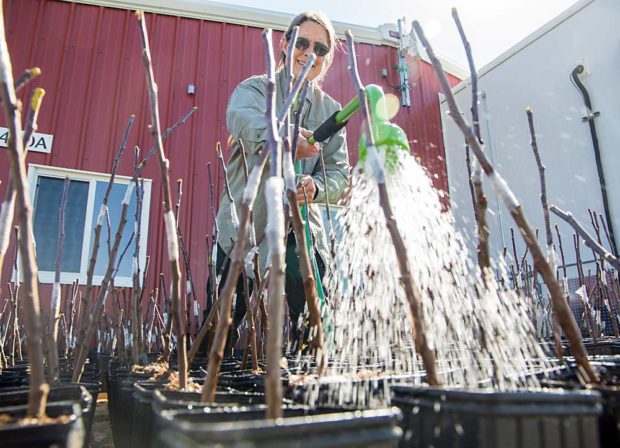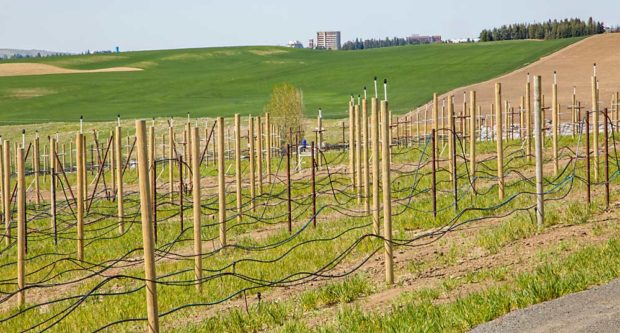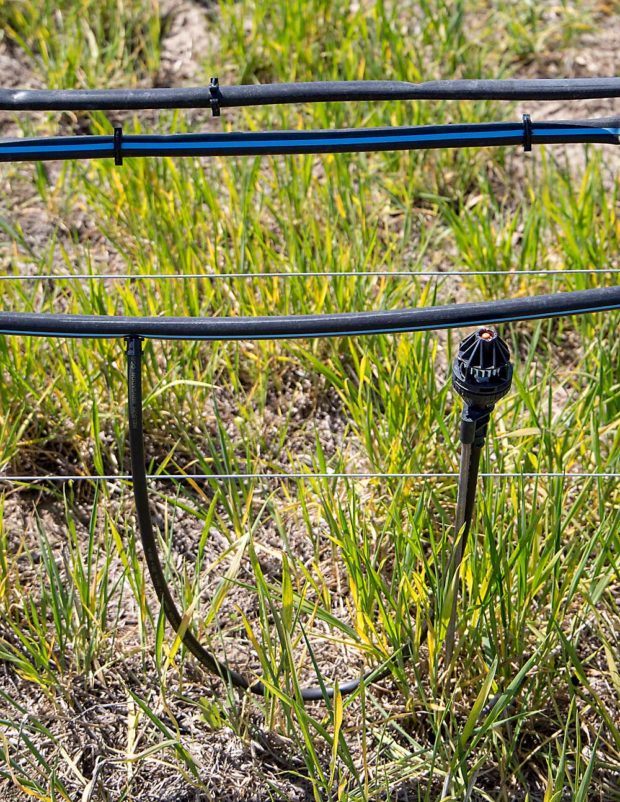
In early May, on a hilltop surrounded by wheat fields, Deb Pehrson individually watered potted apple trees. Visible just over her shoulder, trellises, a deer fence and computerized irrigation awaited the young, grafted plants. Windbreak trees chilled in cold storage.
Slowly and methodically — over the course of a few years — Washington State University is moving its research, teaching and extension orchard to a new home about 2 miles south of the Pullman campus, to make way for an airport expansion near the old site. The new facility will be called the R.B. Tukey Horticulture Orchard.
“It’s not a quick process,” said Pehrson, the longtime farm manager for the orchard. The university hopes to complete the move within three to five years, keeping trees at the old location until those at the new location are established.
And they aren’t actually digging up and moving any trees. They are grafting onto new rootstocks — most of the apples will be on Geneva 11.
The Tukey orchard is used by classes and researchers in a wide array of fields, from pomology to entomology to irrigation. The veterinary school uses the orchard’s apples as rewards for bear behavior studies, while construction management instructors have visited with Pehrson about letting students help design greenhouses for the new facility.
The move was prompted by a long-awaited plan by the Pullman-Moscow Regional Airport to realign and extend its runway to meet Federal Aviation Administration standards for larger aircraft. The old Tukey property included 76 acres overall, roughly 20 of it planted in orchard. The airport now owns more than half of that, leaving only about 6 acres of trees under WSU’s control.
Technically, Pehrson and the university could have just expanded the orchard elsewhere on the property, but they worried they’d just have to move again if the airport expands more in the future. The airport’s master plan calls for either an expanded terminal, or a new one elsewhere on the property, and the acquisition of neighboring land.

Tukey’s new home lies 2 miles south along Johnson Road within the Spillman Agronomy Farm, a sprawling WSU facility consisting mostly of grain fields, for which the Palouse region of Washington is most known. The new Tukey orchard features 10 acres surrounded by deer fencing, plus roughly 5 more acres of perimeter, storage, parking and a packing facility with offices, cold storage and classroom space.
Pehrson has spent most of her working life at the Tukey orchard. She graduated from WSU with a degree in environmental science in 1981 and took the job two years later.
She is excited for the new technology to make her job more efficient and the chance to expose students to orchard systems that resemble those they will one day work in.
It will feature dwarfing trees of modern orchard architecture. All apple scion transferred from the old orchard are being grafted onto Geneva 11 rootstocks and will be irrigated with computer-controlled drip irrigation, as well as under-canopy microspray and overhead cooling sprinklers.
But she will miss the old place, where a unique ecosystem has developed over the years. Hummingbirds whir in the branches of flowering trees, while she finds ladybugs, multiple species of lacewings, minute pirate bugs and scarab beetles, which eat codling moth pupae. She rarely sprays for pests other than codling moth.
She hopes the new site develops that too, eventually, and is seeking advice from WSU entomologist David James on what to plant at the ends of rows. James has studied which surrounding plants harbor beneficial insects for vineyards and plans to do similar research for orchards, next.
“I want habitat, I don’t just want trees and then wheat,” she said.
The old Tukey orchard also features a collection of trees planted in 2010 from leftovers when the university duplicated the Cornell University apple germplasm repository at its Sunrise Research Orchard near Wenatchee. The university will move some of those, too, Pehrson said.

Having a university orchard provides students with a place to gain hands-on experience, said Marcos Quiroz, a WSU integrated plant science graduate who interned at the orchard, helping Pehrson repair irrigation couplings, care for potted trees and other chores. He grew up working on orchards in Royal City, one of Washington’s tree fruit areas, but many of his classmates didn’t.
“A lot of them haven’t even seen a real orchard,” he said.
Some of those students grew up in big city apartment buildings, while the bulk of Washington’s tree fruit industry lies more than a hundred miles west of Pullman.
The airport expansion may have triggered the move, but the university aims to make the most of the opportunities it presents, said Rich Koenig, associate dean of the College of Agricultural, Human, and Natural Resource Sciences and director of WSU Extension.
Students and researchers will get the chance to help plant, construct and build an orchard from the ground up. Koenig also hopes to expand the scope of Tukey to include small fruit, vegetables and ornamentals.
“This is a blank slate and we have not yet planned uses for all of the space,” he said. •
—by Ross Courtney
Related: WSU reveals its wild cider






Leave A Comment